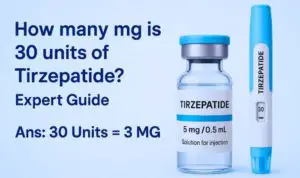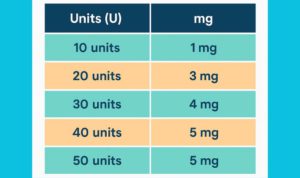
If you’ve been told to take 30 units of tirzepatide, you might be wondering what that means in milligrams. You’re not alone. Many people get confused by units and mg. It’s not always clear how to measure your dose the right way. In this guide, we’ll break it down. No hard math. Just real answers. You’ll learn how many mg 30 units actually are and why it matters for your safety. Let’s get started the easy way.
If you want to know more about Tirzepatide dosing conversion read this blog first [ Tirzepatide Dosage and Unit Conversation Guide ]
Why Tirzepatide Unit-to-mg conversion really matters
Many people take tirzepatide without knowing how to convert units to milligrams. But this small detail can make a big difference. If you take too much, you may feel sick, and if you take too little, it might not work. That’s why understanding the right amount matters.
Each tirzepatide vial or pen has a different strength. Without knowing the mg behind your dose, you could easily make a mistake. This guide helps you avoid that. It provides simple facts, clear math, and no confusion. Knowing your true dose keeps you safe and allows the medicine to work better.
The difference between Tirzepatide units and milligrams
Many people think units and milligrams are the same. But they’re not. Units are how you measure with a syringe. Milligrams are the actual weight of the drug. You might be taking 30 units, but the mg amount depends on the strength of the solution.
That’s why the difference matters. One person’s 30 units may not be the same as another’s. It all depends on the vial or pen they use. Understanding both units and mg helps you take the right dose and stay safe. This small step can protect your health every week.
Exact mg Amount in 30 Units of Tirzepatide
If you’re using tirzepatide and your dose is 30 units, the exact milligram amount depends on the strength of your vial. The most common strength is 1 mg per 10 units, so 30 units would equal 3 mg.
But not all tirzepatide is the same. Some compounded versions or pens may have different concentrations, like 2.5 mg per 10 units. In that case, 30 units could be 7.5 mg. So, you must always check your label or ask your pharmacist.
Getting the mg right is important. It helps your treatment work better and keeps you safe from side effects. Never guess or copy someone else’s dose. Every vial is different, and every patient needs the right amount. Always confirm before you inject.
Tirzepatide Unit-to-mg conversion chart
Tirzepatide doses are measured in units, but the actual drug amount is in milligrams. This chart helps you convert units into accurate mg values easily and safely.

Always double-check your dose and consult your doctor before making any changes to your Tirzepatide medication.
Tirzepatide strengths available in the U.S. market
In the U.S., Tirzepatide has different strengths that fit various treatment needs. The common strengths are 2.5 mg/mL, 5 mg/mL, and 10 mg/mL. Doctors choose the right strength based on your health condition and how your body responds. Lower strengths like 2.5 mg help you start safely, while higher ones like 10 mg give stronger effects. Always follow your doctor’s advice for the right dose and strength.
2.5 mg/mL vs 5 mg/mL vs 10 mg/mL
Typically, the first dosage is 2.5 mg/mL. The likelihood of adverse effects is decreased and your body is able to gradually adapt to the drug thanks to this low dosage. For a safe start to treatment, doctors frequently advise this low dosage.
The 5 mg/mL dose is a moderate choice for people who require stronger effects and can handle the lesser amount. When a stronger reaction is needed, the strongest strength, 10 mg/mL, is recommended. Always advise your physician regarding the appropriate dosage for you.
Is 30 units of Tirzepatide a high dose?
A 30-unit dose of Tirzepatide is considered a moderate-to-high dose, depending on the concentration you’re using. For example, if your pen contains 2.5 mg per 0.5 mL, then 30 units equals 1.5 mg. But if your pen is 10 mg/mL, 30 units could equal 3 mg — a stronger dose.
Your doctor may prescribe 30 units if your body has already adjusted to lower doses and you need greater blood sugar or weight control. It’s not the highest possible dose, but it’s definitely not a starting dose, either. Always follow your prescribed amount carefully.
Why are 30 units usually prescribed?
Doctors often prescribe 30 units of Tirzepatide when patients need a stronger effect after tolerating lower doses. In ongoing treatment plans, it helps manage blood sugar and weight more effectively.
- The patient responded well to a lower dose
- Blood sugar needs tighter daily control
- A higher required dose for weight loss
- The doctor adjusted based on the lab results
- Gradual increase from 15 or 20 units
- Dose optimized for weekly schedule effectiveness
Thirty units are common for ongoing use. But always talk to your doctor before changing your dose—it must be tailored to your personal health needs.
Weight loss vs type 2 diabetes
Tirzepatide is used to treat both type 2 diabetes and obesity, but the treatment goals are different. For type 2 diabetes, it helps lower blood sugar by improving how the body uses insulin. It reduces A1C levels and supports better long-term glucose control. Patients often start with a low dose and increase slowly as needed.
For weight loss, the focus is on reducing appetite and slowing digestion. This helps people feel full for longer and eat less. Tirzepatide is not a quick fix, but it supports steady, healthy weight loss over time. Some people use it for both conditions, but the dose and goal may vary. Your doctor will decide which path is right for you based on your health history and progress.
How to safely inject a 30-unit tirzepatide dose
To guarantee safety and complete efficacy, 30 units of tirzepatide should be carefully injected. Always use the syringe or pen that has been prescribed, and pay strict attention to your doctor’s instructions. Before injecting, clean the injection site. The upper arm, thigh, or stomach are preferred locations.
To prevent inflammation, rotate the injection locations once a week. Never reuse needles, and inject carefully and steadily. Make sure to dispose of the needle properly after the dose. Get in touch with your healthcare practitioner if you have any questions. Using the right injection technique guarantees that your dose will function as intended and helps prevent negative effects.
Tips for home injection and dosing accuracy
Injecting at home may seem scary at first, but it becomes easy with practice and confidence. Follow these simple tips to stay safe and accurate.
- Wash hands before touching the pen
- Use a new needle every single time
- Clean injection site with an alcohol pad
- Inject into fat, not muscle area
- Rotate injection sites to avoid lumps
- Double-check unit markings before injecting
A consistent routine and careful steps will make each injection smoother and safer. If you are unsure, don’t hesitate to ask your doctor or nurse for help.
How long does a 30-unit dose stay in your body?
A 30-unit dose of Tirzepatide is designed to last about one week in your body. It works slowly over time, steadily releasing the medication to help control blood sugar and appetite. This long-acting effect makes it ideal for weekly injections instead of daily ones.
Although the drug’s effects can begin within 24–48 hours, it stays active in your system for up to 7 days. That’s why it’s important to take each dose on the same day every week. Skipping or doubling doses can disrupt your results. Your doctor may adjust the timing based on your response. Always follow your dosing schedule to maintain steady results and avoid side effects.
FAQ
How do I know if 30 units of tirzepatide are right for me?
Ans: Your doctor will decide based on your blood sugar, weight, and how well you respond to lower doses over time.
Is it safe to inject 30 units of tirzepatide at home?
Ans: Yes, if you follow clean injection techniques, rotate sites weekly, and use the correct pen or vial as prescribed.
Can 30 units of tirzepatide help with weight loss?
Ans: Yes, many patients use 30 units weekly to manage hunger, eat less, and achieve slow, steady, and safe weight loss results.
Do all tirzepatide pens have the same mg per unit?
Ans: No, concentrations vary. Always check your label or ask your pharmacist before using a new pen or vial.
What should I do if I accidentally inject more than 30 units?
Ans: Contact your doctor immediately. Watch for nausea, vomiting, or dizziness, and never try to adjust the next dose yourself.
Conclusion
Understanding what 30 units of tirzepatide means in milligrams is not just about numbers—it’s about staying safe and getting results. Whether you’re using it for weight loss or to manage type 2 diabetes, the exact tirzepatide dosage matters. Taking too little won’t work, and too much can cause side effects. That’s why knowing how to convert units to mg is essential. It’s a simple step that makes your treatment safer and more effective.
Before injecting, always double-check your prescription, pen concentration, and dosage chart. Talk to your doctor if you’re unsure. With the right knowledge and routine, 30 units of tirzepatide can support steady progress toward better health. Stay consistent, follow your schedule, and never guess your dose. Smart dosing means safer results—week after week.
Trusted Medical Resources:
- Drugs.com – Tirzepatide Drug Information
- WebMD – Mounjaro (Tirzepatide) Overview & Side Effects
- NIDDK – FDA-Approved Weight Management Medications
⚠️ Medical Disclaimer:
This content is provided for informational purposes only and does not replace professional medical advice. Always consult your doctor or pharmacist before starting or changing any medication.
✅ Reviewed by: CMH Health Editorial Team
Hello everyone, I’m Mehedi Hasan — a passionate health content creator and the founder of CMH Healths. Since 2015, I have been researching and writing about health topics with the goal of helping people live healthier and more informed lives. I focus on creating practical, research-based content on health and medicine that empowers readers to make confident, evidence-backed decisions.
